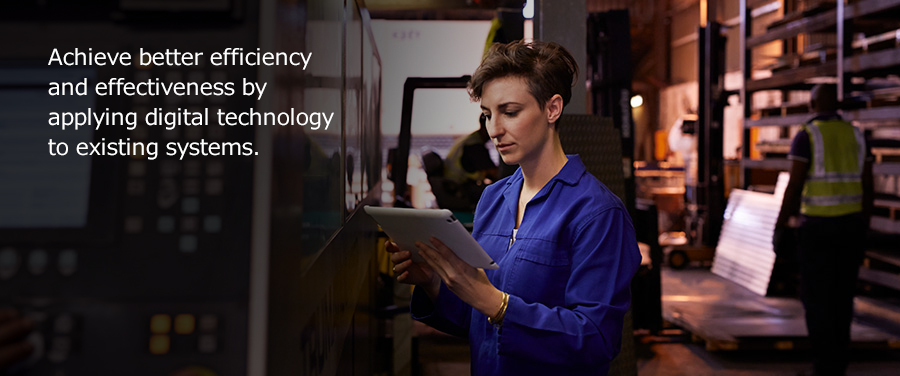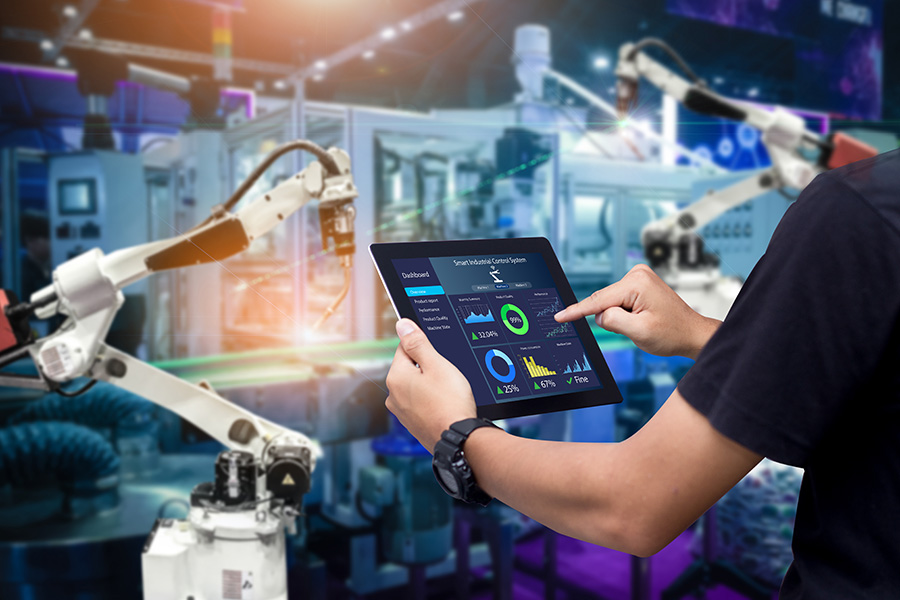Remaining competitive in the manufacturing arena requires digitalization and automation of your operations. The industrial internet of things (IIoT), advanced data analytics, artificial intelligence, machine-to-machine learning and cloud computing are all helping manufacturers achieve new levels of operational efficiency based on real-time, data-driven insights. Digital transformation in manufacturing can not only help improve productivity and quality, it can also deliver better worker safety, reduce energy usage and increase sustainability for your organization. Digital transformation is well beyond a trend — it is a strategic imperative.
If your firm is teetering on the edge of transformation, it’s likely that you’re feeling a sense of urgency to move forward, but have some concerns, too. You’re not alone. We’ve identified the following five top challenges to fully embracing digital transformation and achieve resilience in manufacturing :
We also have some practical, proven advice for how you can overcome these challenges to accelerate your digital transformation and begin reaping the benefits.

The overarching goal in transforming the manufacturing environment is better overall equipment effectiveness (OEE). Improved OEE increases efficiency and yield, reduces or eliminates scrap, and improves quality — all of which leads to an improved return on investment (ROI) as well as a more sustainable, efficient, environmentally responsible enterprise. IIoT can help you accomplish all these goals. These five steps can get you there:
Your fundamental strategic principle should be to leverage data - a powerful driver of Manufacturing 4.0 transformation to gain deeper insights for greater business agility, improved manufacturing operations and innovation. Begin by setting priorities based on business needs, not on technology. Technology is a tool, not a strategic imperative in itself. Identify your business objectives and develop a priority-based transformation strategy that leverages the right technology to achieve your goals — including your long-term sustainability goals.
An effective digital transformation strategy aligns your existing and future investments with the outcomes you want — and paves the way for a sustainable future. For example, when your processes run more efficiently, you can improve how you use everything from raw materials to energy. More efficiency can reduce scrap and waste — and even greenhouse gases, making your digital transformation journey a win not only for your organization but for the world. Hitachi’s Stairway to Value framework can help you develop your plans for a digital environment. i With a successfully implemented strategy, your organization will be able to connect equipment, visualize and analyze data in real time, and benefit from predictive and prescriptive processes for long-term value.
With so many technology options, it can be difficult to know where to start with digital transformation. You likely already have many systems in place, such as an enterprise resource planning (ERP) system and a manufacturing operating system (MOS). Rest assured that there’s no need to reinvent the wheel. You can achieve better efficiency and effectiveness by applying digital technology to existing systems.
Start by assessing your biggest challenges, where there is variability in your processes, and where you have the highest cost centers. Then brainstorm issues (use cases) with your team. You might have diverse results in different areas of your organization. Break big problems down into smaller parts. Once you’ve identified problems, identify their financial impact and degree of difficulty. Then prioritize each issue or use case by creating a four-quadrant, risk-to-value model that maps the financial impact on the y-axis and the risk/difficulty on the x-axis.

Even after the prioritization exercise, you may still have a list of high-priority, high-value digital transformation use cases, all of which are important. However, it’s best to start small. Tackle bite-sized projects that have an achievable ROI. If you used the risk-to-value model in step 2, you can see which issues are lower risk. These issues might also have a smaller impact, but they are often the easiest to accomplish and can be a good place to start.
This first use case is crucial to your future success because it gives you the opportunity to test the waters, engage your people and provide a proof point that can give your organization the confidence it needs to take the next steps. Also, this first use case can illustrate where there may be gaps in skills, tools or technology that could hinder your progress in building your smart factory. Learn from this first use case. This is an opportunity to identify issues that could slow down your transformation’s progress. Address them early to mitigate risk as you add more use cases.
Doubts about whether the transformation will pay for itself can make you hesitant to make your first investment. Establish key performance indicators (KPIs) and link them to financial goals or some other measurable value; for example, production uptime versus downtime or scrap versus yield. Your first use case is also a test for proving that your digital transformation efforts will yield results. Even a small project can demonstrate the opportunity to yield savings in the future. Using KPIs will help your organization stay within scope and get the results you anticipate with measurable ROI.
Remember, don’t focus on technology. All too often, the attraction of “cool” technology can distract from the real purpose of a transformation initiative. Any technology you employ must be part of your ROI model and be tied directly to business priorities. If the technology doesn’t align with your intent and processes, don’t waste time and money on it.

Building a strong and successful infrastructure for digital transformation requires much more than acquiring and implementing the latest technology. It begins with people. Digital transformation is a cultural transformation as much as it is a technology transformation. You may have the right tools and partners, but without engaged employees, your transformation will fail. Take the time to identify and communicate with all the stakeholders across the organization. It is essential that they understand and support this transformation. Acknowledge that change is disruptive, while emphasizing that it also brings opportunities and is necessary to the long-term sustainability of the organization. Take time to inform and engage your people, help them acquire new skills where needed, and evangelize the value of digital transformation for the entire organization.
You can fast-track your manufacturing automation and digital transformation efforts by setting clear goals, identifying areas of variation, selecting the right digital transformation use cases and focusing on results. Creating an executive advisory board and seeking advice from the outside will boost your efforts. For example, co-innovating with suppliers and customers can help you derive shared value that benefits everyone.
Remember, you’re not alone. Someone else has faced and overcome similar challenges. Learn from those who’ve been there — and let us help you, too.

McKinsey estimates that the majority of attempts at digital transformations failii. Fail-proof your transformation journey by co-creating your solution with a provider that has both information technology (IT) and operational technology (OT) expertise.
Hitachi is a global leader in innovative industrial and information technology solutions and an early pioneer of the internet of things. We believe in the power of co-creation and innovation for economic, environmental and social good. A digital and sustainable manufacturing environment not only delivers increased corporate value, it improves the quality of life for all.
We’ve helped our customers take advantage of many opportunities to improve their production environments and inculcate smart manufacturing — from improving plant safety to delivering better efficiency with raw materials to reducing energy usage. For example, one of the largest suppliers of aluminum sheet in North America, Logan Aluminum, partnered with Hitachi to stay competitive and deliver better quality products by adopting a digital transformation approach. Hitachi designed a 2-day Smart Manufacturing Solution Envisioning Workshop that helped the company meet its environmental, safety, product quality and production efficiency goals, all while lowering costs. As a result, the company is projected to significantly improve performance and availability, and reduce risk incidents and operational costsiii.
Hitachi has the capabilities to help organizations build connected factories through digitalization in manufacturing, maximize operational efficiency and realize measurable, sustainable business results. From sensors to analytics, storage and more, we have both the OT and IT tools and experience to help you transform your factory while keeping costs low and reducing your environmental footprint.
And that's not all. With advanced robotics for manufacturing, Hitachi is also driving warehouse automation to create more efficient, durable supply chains.
The more efficient you are, the greater your contribution to smarter manufacturing, which benefits everyone. At Hitachi, Powering Good is behind everything we do.
Read this white paper to learn more about accelerating digital transformation in manufacturing.